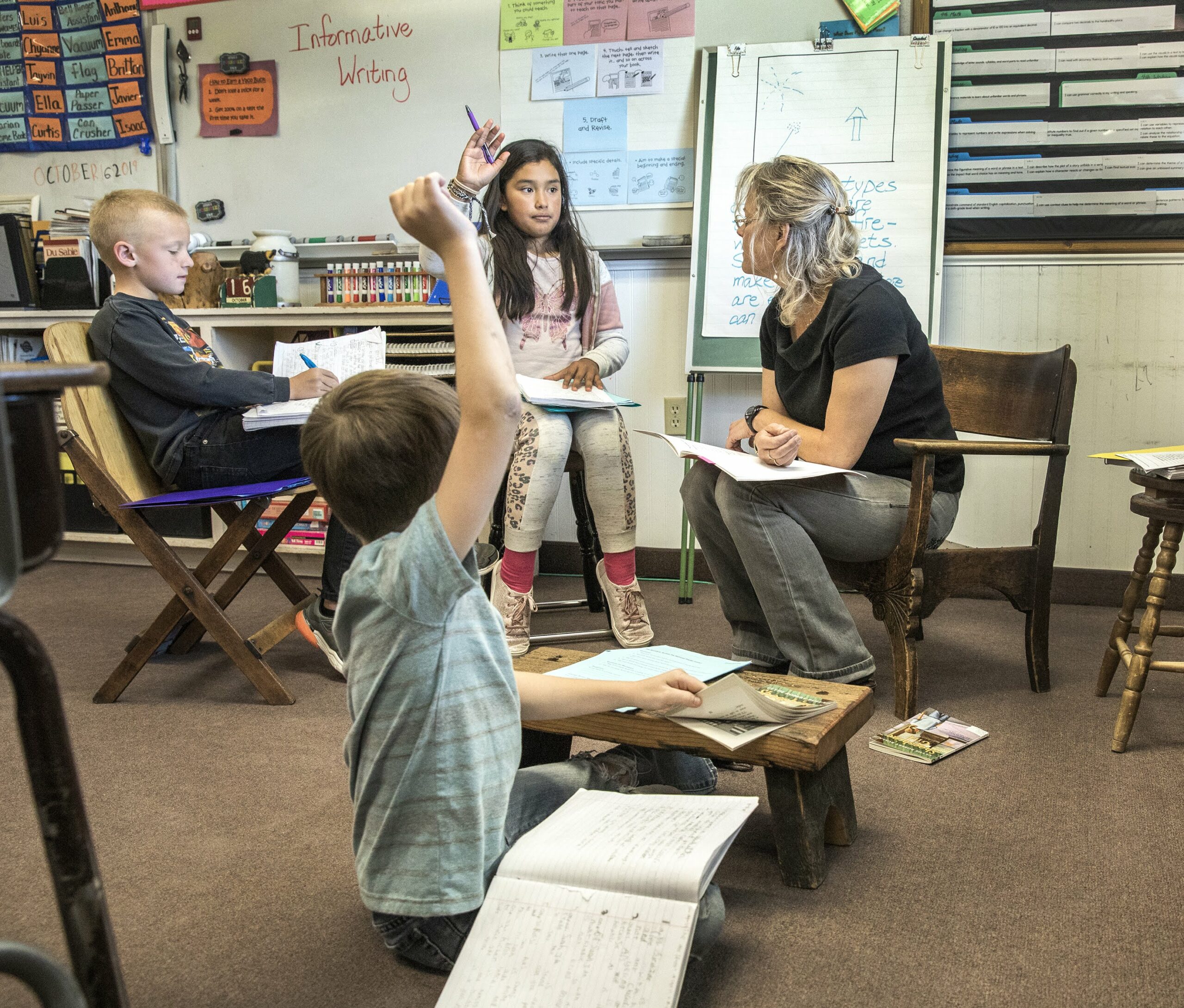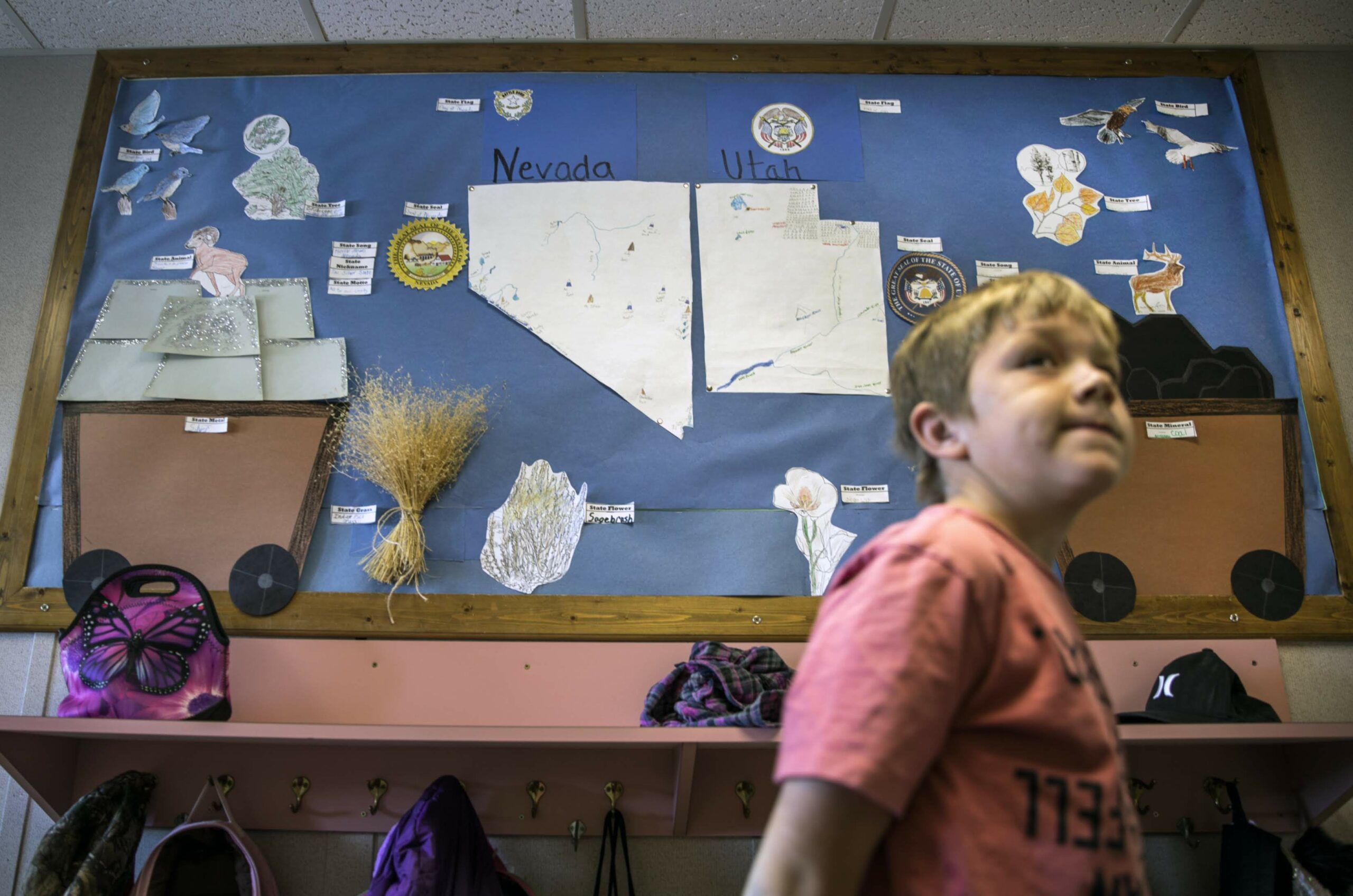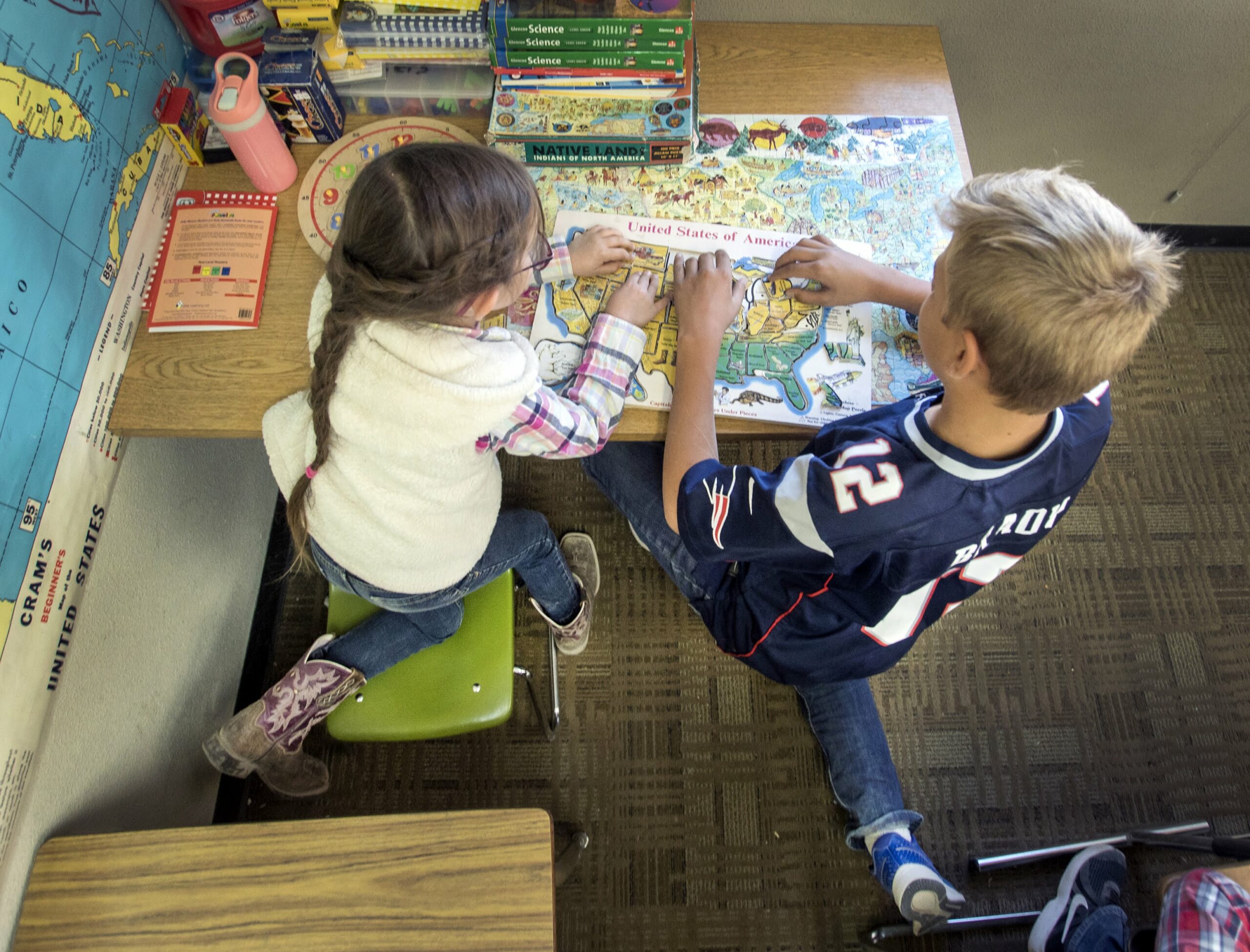Three third-graders fidgeted as they scanned their books for inspiration.
They were trying to come up with an adjective to describe the main character in a story about a shoeshine stand. Nestled among them in a small circle, their teacher, Heather Yacapraro, delivered special instructions. She didn’t want to hear generic words like “happy,” “sad,” and “nice.”
“What do you call it when we take on things by ourselves?” she asked, trying to activate their vocabularies. “It’s a longer word.”
On first glance, this scene features all the hallmarks of small-group instruction — a teacher working directly with several students who are on the same academic level. And it is. But in this classroom, the learning style is by geographic necessity, not purely pedagogical choice.
Across the room, a boy whispered “Five … six … seven” while calculating a math problem.
Another student asked to borrow Yacapraro’s eraser.
And others quietly completed writing assignments.
They’re all fourth- or fifth-grade students working independently while their teacher instructs the third-graders, who eventually suggested an adjective: “Responsible.” The word rings true at Baker Grade School in eastern-central Nevada, where students in third through fifth grade must be self-starters because they learn alongside each other in a single classroom. With three grades sharing a teacher, the school’s 14 students know the drill. It’s their responsibility to stay on task while Yacapraro rotates through the grade levels.
“They have to have their own independent streak,” Yacapraro said, “and it’s kind of bred into them.”
Once a fixture in rural America, one-room schoolhouses have become an endangered species, closed over the decades as better transportation gave way to sprawling educational facilities that house up to several thousand students. But Nevada’s vast and sparsely populated landscape has kept these time-honored institutions alive in some far-flung locales.
Baker Grade School even boasts a giant bell just outside its front door. At 2:30 each weekday afternoon, a student pulls a blue- and white-colored rope three times and the ding-ding-ding of the bell signals the end of the school day.
While these quirks add to the charm of one-room schoolhouses, they’re also emblematic of a traditional learning experience that educators say benefits both students and teachers. And despite what their shape-centric name may suggest, no two one-room schoolhouses are built the same. Each has its own character.

A one-room schoolhouse for two states
On a sunny morning, Yacapraro and Chandra Conrad — a teacher aide who doubles as an administrative assistant — sat on a picnic table and watched their 14 students play tag. Back and forth the kids went across the field, the younger ones trailing the older.
Shrieks of laughter drifted through the crisp fall air. No angry shouts or tears.
The teaching duo said this is normal at Baker Grade School, which sits in the shadows of Great Basin National Park. Aside from some catty arguments, the multi-grade classmates generally get along, which may be a function of their bonded nature — or the fact that there’s no escaping each other in this one-room school.
“It’s a bummer when someone gets isolated, so we try to quash that out pretty quickly,” Yacapraro said.
Not all characteristics distinct to Baker Grade School are obvious to her, though. The veteran educator has never taught anywhere else. Yacapraro spent her college summers waitressing at a cafe her mother ran inside the national park. She returned with a bachelor’s degree in English literature and no job prospects. So she took a job as a teacher’s aide at the tiny school in the tiny, unincorporated town. Baker has roughly 80 residents, and the entire Snake Valley area, which straddles the Nevada-Utah border, has closer to 250.
Undeterred by the population size (or lack thereof), Yacapraro found her calling and started working toward her teaching certification. Then the full-time teaching position opened.
“I applied for the job and when I went in for my interview, the superintendent said, ‘Now, you live in Baker?’” she recalled. “And I said, ‘Yeah.’ And he said, ‘You got the job.’ Easy interview.”
That was in 1992. Hundreds of students have flowed through this one-room schoolhouse since then. Although correct in the operational sense — one licensed educator teaching multiple grade levels in a single classroom — there’s more than one room in this schoolhouse. There’s a main classroom, filled with the normal trappings of indoor school life such as an alphabet poster, a rules chart, a chalkboard and an American flag. Across the hall is a computer lab. Two other rooms down the hall serve as cafeteria, multi-purpose space, office and health clinic depending on the time of day and need.

But a hallway bulletin board really highlights the abormality that sets this school apart.
Construction paper outlines of Nevada and Utah, surrounded by images of state minerals, flowers, trees and animals, decorate the bulletin board. It’s a necessary lesson at this school, which enrolls children from both states. The situation is made possible by a decades-long interstate agreement between the White Pine County School District, which includes Baker, and the neighboring Millard School District in Utah.
Here’s how it works from an enrollment standpoint:
Baker Grade School educates the region’s children in grades third through sixth, although there’s no sixth-graders in the current crop of students. Meanwhile, kindergarten through second-grade students attend school in Garrison, Utah, while the older kids — seventh- through 12th-graders — receive their education in EskDale, Utah.
And from a financial standpoint:
White Pine counts students who reside in Nevada for apportionment purposes, while Millard does the same for students living in Utah. Per a tuition agreement, the two districts send each other per-pupil dollars for every non-resident student who attends school there.
And from an academic standpoint:
Both states use the Common Core, a set of K-12 academic standards for English language arts and mathematics. The deviation occurs in fourth grade, when students learn state history. Yacapraro teaches both Nevada and Utah concepts, unless the grade only includes students from one state.

But for all the things the students have in common — a rural upbringing, easy access to outdoor activities and parents who work as ranchers, national park employees or rock quarry employees — there’s one difference that comes down to the state line: the time on their residential clocks.
Utah, which sits in the mountain standard time zone, is an hour ahead of Nevada, creating a tricky situation for Baker Grade School.
“The time zone is interesting,” Yacapraro said. “Most people, by the time their kids are in school, are getting used to it.”
Still, every flyer that goes home lists “Nevada time” and “Utah time” to make it crystal clear, said Yacapraro, who has become a classroom magician juggling the needs of her multi-level students. A thick binder houses her neon-colored lesson plans, separated by rows and columns with small font listing time of day, academic subject and missions for each grade level. On this week, her students are reading three different books — “The Shoeshine Girl” for third-graders, “Snow Treasure” for fourth-graders and “Number the Stars” for fifth-graders — which means Yacapraro must keep up with the plot lines in each story.
The constant pivoting doesn’t faze Yacapraro, whose class sizes at Baker Grade School have ranged from 11 to 25 students. She credits Conrad, the teacher’s aide, with helping her keep the operation afloat.
But the school’s principal, Robert Bischoff, who also oversees the 124-student McGill Elementary School, said Yacapraro makes being a one-room schoolhouse educator “look seamless and easy.” He pointed to the school's four-star rating under the Nevada School Performance Framework as evidence of her prowess.
“The kids out here actually do really well academically as well,” he said. “They usually score higher than the kids in the rest of the county.”
Bischoff said the regional culture likely plays a role, too. School events draw community members from both sides of the state line, including residents who don’t have young children.
“The people here in the valley just envision their kids as the future,” he said. “And so they put aside political differences in state line and everything else and they just work together for the kids. And so it’s really refreshing to see.”

The past and present
The Nevada Department of Education doesn’t keep a running list of one-room schoolhouses. Instead, the frontier-era icons blend into the state’s overall education landscape, providing a learning lab in remote places.
Bill Sherman, a member of the Country School Association of America’s board of directors, said about 200 operating one-room schoolhouses exist across the nation today. But the self-described country school preservationist suspects that number would be much greater if it included homeschool settings and private schools in Amish and Mennonite religious communities.
“I would argue there (are) many more than 200 operating one-room schools in America, but really no one knows how many,” he said. “It isn’t collected by the U.S. Department of Education. Some states collect it. Many don’t.”
Even so, a certain fascination surrounds the quaint schools. The Country School Association of America holds an annual conference that draws people interested in current and former one-room schoolhouses, said Dr. Veronica Ent, the association’s president and education department chairperson at Saint Vincent College in Latrobe, Pennsylvania.
Every year, Ent takes her graduate students to a nearby one-room school that has been preserved as a historic site, replete with the teacher’s original curriculum.
Her education students appreciate the creative freedom the one-room schoolhouse teacher exercised rather than adhering to a “cookbook-style of teaching” that’s common nowadays, she said. But they also discuss the culture that such environments engender. Decades ago, as American education shifted toward larger buildings with multiple classrooms and a robust teaching staff, the sense of community common in one-room schools became more difficult to replicate.
“They actually start to govern themselves and become their own family,” Ent said. “A lot of times in larger schools, where kids are shuffled from classroom to classroom, they don’t get that relationship — that strong relationship together.”
Those relationships breed natural peer assistance, Ent said. Whereas coordination must occur in larger schools — such as when a higher grade adopts a lower grade as reading buddies — the older students can just turn around or walk a few feet to help a younger classmate in a one-room schoolhouse. On the flip side, older students benefit from built-in repetition when they overhear previous concepts taught to the children in lower grades.
Of course, drawbacks exist, too. Extracurricular activities can be limited or nonexistent, and some students may not be too keen on having the same teacher every year.
“For the most part, though, getting to know your student and having that legacy with them is a good thing,” she said.

A school on a cattle ranch
More than two and a half hours west of Baker, eight children kick up dust on a dirt patch as they play outside a modular building on an October morning. They dart this way and that, avoiding a handful of bouncing balls. Unlike their tag-playing peers to the east, the game here resembles dodgeball.
When a handbell rings, the children stop in their tracks. Then they bound up six metal steps and under a sign that reads, “Welcome to Warm Springs School.” It’s a one-room schoolhouse for kindergarten through eighth-grade children in the Nye County School District.
Inside the classroom, the rhythm feels strikingly similar to Baker Grade School. The teacher, Joseph Burch, meanders the room while reading aloud spelling words: “product,” “journal,” “garbage,” “whiskers.” Two third-graders, who are twin boys, and a second-grade boy jot down the words. Nearby, a 6-year-old girl scans a picture book. And on the other end of the room, the older kids, who are in fifth, sixth and seventh grade, read a passage about the Trojan War.
Outside, chickens waddle in their coop, two dogs roam the property, horses wander into their pen and a desert tortoise named Tortilla prepares for brumation. This is life at a one-room school located on a cattle ranch, where the students' lunchtime conversations transition seamlessly from horse roping to a superstar Las Vegas deejay.
“I didn’t mean to, but I made this one look like Marshmello,” sixth-grader Giovanni said, pointing to a cupcake and referring to the deejay.
Giovanni and three of his classmates had baked the cupcakes the prior night. His parents, Anna Fallini and Ty Berg, own the ranch that houses the school. But in this isolated, high desert location, neighbors are few and far between, which is why three students spend the night during the school week. Their family’s ranch is about two hours away. So the siblings — a girl and her two brothers — sleep in a bedroom next door to Giovanni’s.
And their teacher lives in a cottage on the property, too. But if he joins his students for dinner, he’s still “Mr. Burch” inside the home.
“If the kids know you care, if they like you, you like them, the discipline almost takes care of itself because there’s a respect established there,” he said. “And a lot of times, you don’t even have to worry about that relationship getting blurred. It’s easier anyway.”
For Burch, who started teaching here in March 2017, Warm Springs School feels like a return to home. He grew up on an Idaho ranch before teaching in several western states, Alaska and Europe. He said there’s an unspoken understanding between him and the five ranching families whose children attend the school.
“As far as the culture here, there is no kind of a knowledge gap there,” he said. “If the families say we have to be home today to do this chore, I know exactly what they’re saying. I know that’s going to take them all day. I know that it takes as many people as possible. So I’m able to say, ‘Yeah, you know, I understand.’”
The school, however, is a relatively new addition to the state’s education portfolio. Just four years old, it grew out of Anna Fallini’s desire to provide a more normal education experience for Giovanni, on outgoing and energetic kid who makes friends easily. She initially homeschooled him, but over time, it became obvious that wasn’t the best fit for them. He craved social interactions. She craved a more motherly role.
“I was spending all this time with Giovanni in school —pushing, pushing, pushing — and then school would get out and the time we should be doing fun things together, we were trying to get our own personal time,” she said. “So I was spending no what I’d call your ‘mom and kid time’ with him.”
Around the same time, Fallini realized there was a demand for an actual school — much like the one her grandmother and father attended — among the region’s ranching families. Once they secured the modular building, it paved the way for the Nye County School District to green light the school and hire Burch.
Now, Giovanni, a fifth-generation rancher, has friends who have become more like siblings. And the one-room school has provided a classroom experience with structure, discipline and social interaction for Giovanni and his peers.
“They fight, but then they protect each other and they, you know, they laugh,” Anna Fallini said. “They get along great.”
Those experiences will come in handy several years down the line when they head off to high school — likely in another town or school district.
But that’s not something they dwell on now because it signifies the break-up of their bonded group. On Thursday afternoon, the last day of their school week, the children piled into their parents’ sport-utility vehicles or pickup trucks and bid each other goodbye.
At least until Sunday night when half the students would be back on the ranch.